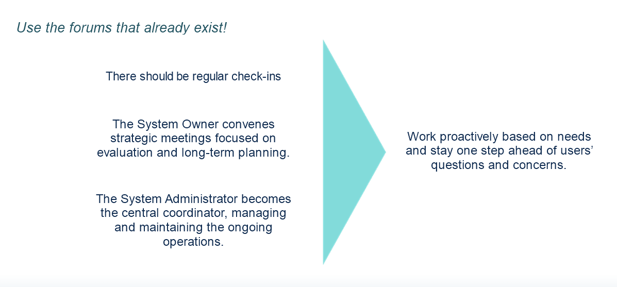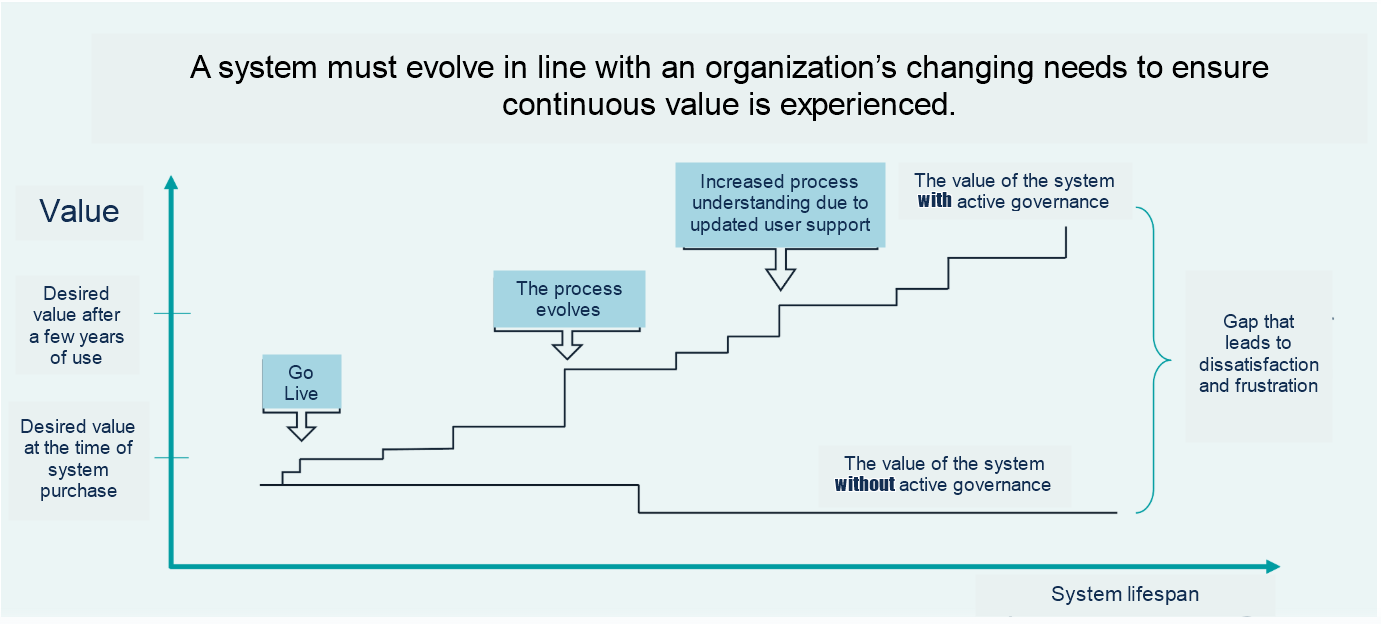Why is a governance organization needed?
When users don't know where to turn with questions or don't receive timely responses, it creates frustration and unnecessary resistance within the organization. These are often issues that could be prevented through automation or structured training routines—but who is actually responsible for this within the organization?
As organizational needs change, the system must also adapt. Even though new developments from Stratsys enable smoother workflows and new possibilities, change will always bring questions. Users in operational departments may wonder what is expected of them in the system, and managers in operations and administration will have questions about responsibilities for goal breakdowns and follow-up.
Even though the value derived from the system increases over its lifetime, effective governance is required for that to happen. The long-term impact of an active governance organization becomes even more apparent over time. Without it, a gap will grow between the value you expected—or could have gained—from Stratsys and the actual experience of the system.
Fortunately, together with our customers, we at Stratsys have identified several success factors for establishing an active governance organization—so that users ultimately get the support they need.
The benefit: How does Stratsys become an effective operational support tool?
How do you achieve this?
It is the usage that creates the value! That’s why it is important to create the best conditions for users and the organization as a whole through a well-functioning governance organization. In our experience, meeting these needs and getting this in place requires the organization to clarify:
-
What information should be documented in the system and how should it be documented?
-
What is expected from users, and how is this communicated?
-
What ready-made support is available in manuals and e-learning, and how do users access it?
-
Where do users turn for answers to their questions—both organizational and technical?
-
Who receives suggestions for improvements, compiles them, and ultimately decides what gets acted on?
To achieve this, in addition to technical knowledge of the tool, the organization must also have a solid internal structure and a clear, ongoing dialogue between management and users—for example, through regular check-ins with a collaboration group.
There is no one-size-fits-all solution that can be applied to every organization without adjustments. However, in our experience, a governance organization with clearly defined roles and responsibilities is a good first step. Add regular check-ins with a relevant collaboration group, and you're well on your way.
Solution – What should an active governance organization look like?
Below is an example of how a governance organization can be structured in Stratsys. The names and specific responsibilities should be adjusted to fit your context, but generally speaking, a structure like this provides a strong foundation for how your organization can work effectively in Stratsys.
All roles and responsibilities listed are our recommendations.
System Owner
-
Strategically overarching and ultimately responsible for ensuring that the system meets the intended needs and objectives.
-
Responsible for contracts and financial matters
-
Maintains ongoing dialogue with the System Administrator and internal stakeholders responsible for the processes supported by Stratsys products
Full Administrator / System Administrator
-
Holds overarching practical responsibility for the system and its development (for example new products)
-
Leads governance work and system development through surveys and internal networking
-
Maintains ongoing dialogue with the System Owner and other administrators
Product Administrator
-
Responsible for their respective product and its continuous development
-
Maintains ongoing dialogue with other administrators and internal stakeholders responsible for the process the product is intended to support
Local Administrator
-
Has in-depth knowledge of the system and acts as the first point of support for users in need
-
Can manage basic administrative functions for their organizational unit and its sub-units
-
Serves as a link between the System Administrator, the organization, and the users
-
Maintains ongoing dialogue with other administrators and the organization/system’s users
IT
-
Often not involved in day-to-day operations but should be available to ensure that the Stratsys platform is part of the internal IT roadmap.
-
Has insight into the necessary functionalities for efficient use of Stratsys, such as SSO/AD solutions, required integrations, and more.
How the Governance Organization Works Together
A clearly structured governance organization with well-understood role expectations is, as previously mentioned, a great start. However, to stay ahead, this should be combined with forums where the right people can meet and collaborate. While the structure of these forums may vary between organizations, there are some general prerequisites and tips that we can share. These can help you work more proactively toward users and provide the best possible conditions for success.

Examples of how different forums can be structured and how frequently they meet.
| Meeting / Forum | Frequency | Participants |
|---|---|---|
| Administrator Check-in | Monthly or in connection with key Stratsys events (for example major reporting periods) |
System Administrator Super Administrator Local Administrators |
| Quality Group Meeting | Every two months |
System Administrator Process Leader for Goal Management Process Leader for Quality Management Process Leader for Internal Control |
| Semi-Annual Review | Twice a year |
Stratsys Account Manager All Roles |
|
Development Council preferably preceded by an internal survey |
Annually | All Roles |
In summary, it is important to maintain ongoing dialogue and continuous development around Stratsys to ensure that the system continues to support your way of working and serves as an effective operational tool. Good luck!

